ES6 的class可以看作只是一个语法糖,它的绝大部分功能,ES5 都可以做到,新的class写法只是让对象原型的写法更加清晰、更像面向对象编程的语法而已。(所以其实不要和面向对象的class 混为一谈,因为并不是真正意义上的类)
ES5:(之前的博文中有记录过this,优先级new 是最高的,并且如果是new 方法创建的实例,等于是复制了一份,this指向自身)

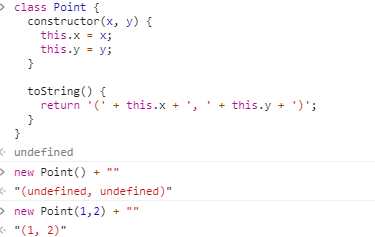
constructor构造方法,this关键字则代表实例对象(与ES5 一致)。
class 创建的类与ES5 中创建的函数有所不同,下面如果直接执行call 方法,提示类的构造器不能没有new 去执行,必须要创建实例才可以。

类的数据类型就是函数,类本身就指向构造函数。

在类的实例上面调用方法,其实就是调用原型上的方法。


class B {}
let b = new B();
b.constructor === B.prototype.constructor // true
由于类的方法都定义在prototype对象上面,所以类的新方法可以添加在prototype对象上面。Object.assign方法可以很方便地一次向类添加多个方法。
class Point {
constructor(){
// ...
}
}
Object.assign(Point.prototype, {
toString(){},
toValue(){}
});
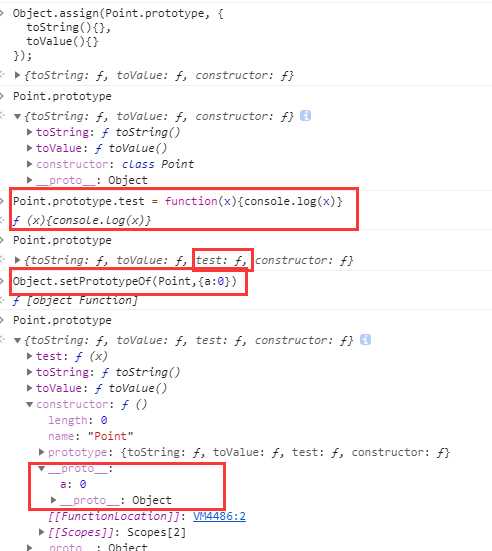
设置对象原型的时候,a 丢到了Point 类的构造方法的原型中。
prototype对象的constructor属性,直接指向“类”的本身,这与 ES5 的行为是一致的。
Point.prototype.constructor === Point // true
内部所有定义的方法,都是不可枚举的(non-enumerable)。这一点与 ES5(可枚举) 的行为不一致。
ES5 一样,实例的属性除非显式定义在其本身(即定义在this对象上),否则都是定义在原型上(即定义在class上)。
//定义类
class Point {
constructor(x, y) {
this.x = x;
this.y = y;
}
toString() {
return ‘(‘ + this.x + ‘, ‘ + this.y + ‘)‘;
}
}
var point = new Point(2, 3);
point.toString() // (2, 3)
point.hasOwnProperty(‘x‘) // true
point.hasOwnProperty(‘y‘) // true
point.hasOwnProperty(‘toString‘) // false
point.__proto__.hasOwnProperty(‘toString‘) // true
getter、setter:
class MyClass {
constructor() {
// ...
}
get prop() {
return ‘getter‘;
}
set prop(value) {
console.log(‘setter: ‘+value);
}
}
let inst = new MyClass();
inst.prop = 123;
// setter: 123
inst.prop
// ‘getter‘
类的属性名,可以采用表达式。
let methodName = ‘getArea‘;
class Square {
constructor(length) {
// ...
}
[methodName]() {
// ...
}
}
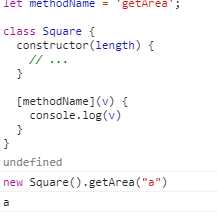
表达式:(有点像函数)
const MyClass = class Me {
getClassName() {
return Me.name;
}
};
const MyClass1 = class{
getClassName() {
return Me.name;
}
};
const foo = function test(){}

采用 Class 表达式,可以写出立即执行的 Class(必须要有new)。
let person = new class {
constructor(name) {
this.name = name;
}
sayName() {
console.log(this.name);
}
}(‘张三‘);
person.sayName(); // "张三"
类和模块的内部,默认就是严格模式,所以不需要使用use strict指定运行模式。
类不存在变量提升(hoist),这一点与 ES5 完全不同。
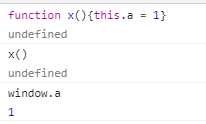
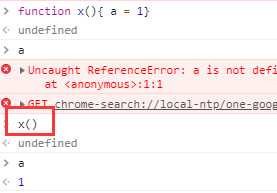
变量提升到全局window。(作为使用new 创建的对象实例,本身this也是指向自身)
由于本质上,ES6 的类只是 ES5 的构造函数的一层包装,所以函数的许多特性都被Class继承,包括name属性。
如果某个方法之前加上星号(*),就表示该方法是一个 Generator 函数。
class Foo {
constructor(...args) {
this.args = args;
}
* [Symbol.iterator]() {
for (let arg of this.args) {
yield arg;
}
}
}
for (let x of new Foo(‘hello‘, ‘world‘)) {
console.log(x);
}
// hello
// world
类的方法内部如果含有this,它默认指向类的实例。但是,必须非常小心,一旦单独使用该方法,很可能报错。
全局方法/静态方法:如果静态方法包含this关键字,这个this指的是类,而不是实例。
class Foo {
static classMethod() {
return ‘hello‘;
}
}
Foo.classMethod() // ‘hello‘
var foo = new Foo();
foo.classMethod()
// TypeError: foo.classMethod is not a function
class Foo {
static bar() {
this.baz();
}
static baz() {
console.log(‘hello‘);
}
baz() {
console.log(‘world‘);
}
}
Foo.bar() // hello
类可以被继承(extend):Bar继承了Foo 类,Bar的原型指向Foo
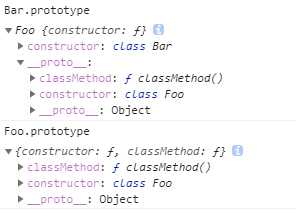

静态方法也是可以从super对象上调用的(非静态方法也可以)。
class Foo {
static classMethod() {
return ‘hello‘;
}
}
class Bar extends Foo {
static classMethod() {
return super.classMethod() + ‘, too‘;
}
}
Bar.classMethod() // "hello, too"
实例属性除了定义在constructor()方法里面的this上面,也可以定义在类的最顶层(注意没有this)。
class IncreasingCounter {
_count = 0;
get value() {
console.log(‘Getting the current value!‘);
return this._count;
}
increment() {
this._count++;
}
}
静态属性指的是 Class 本身的属性,即Class.propName,而不是定义在实例对象(this)上的属性(第一种跟ES5 之前一样)。
class Foo {
}
Foo.prop = 1;
Foo.prop // 1
目前最新的写法。
class MyClass {
static myStaticProp = 42;
constructor() {
console.log(MyClass.myStaticProp); // 42
}
}
私有方法和私有属性(class 暂不直接支持,只有通过变通的方法,因为class 其内部this本身就是指向实例自身)
ES5:
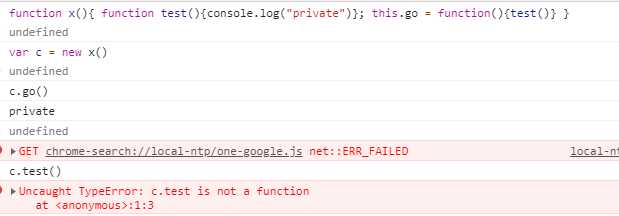
ES6:
class Widget {
foo (baz) {
bar.call(this, baz);
}
// ...
}
function bar(baz) {
return this.snaf = baz;
}
bar 成为了类的私有方法。
私有属性提案(chrom最新版可以使用了,火狐67.0 未支持)class加了私有属性。方法是在属性名之前,使用#表示,内部使用this.#xxx 访问。
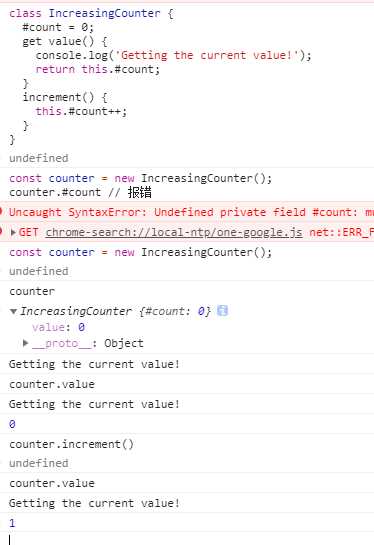
对比:
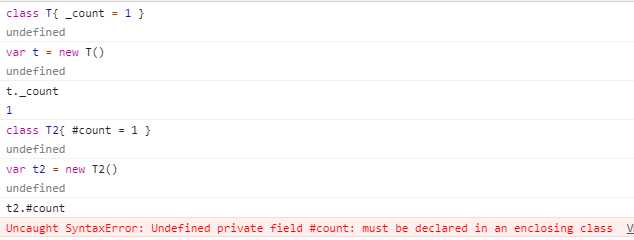
私有方法:貌似暂时不支持
new是从构造函数生成实例对象的命令。ES6 为new命令引入了一个new.target属性,该属性一般用在构造函数之中,返回new命令作用于的那个构造函数。如果构造函数不是通过new命令或Reflect.construct()调用的,new.target会返回undefined,因此这个属性可以用来确定构造函数是怎么调用的。
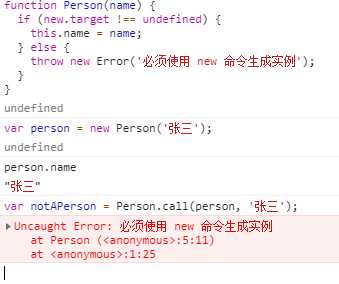
利用这个特点,可以写出不能独立使用、必须继承后才能使用的类(子类继承父类时,new.target会返回子类)。
class Shape {
constructor() {
if (new.target === Shape) {
throw new Error(‘本类不能实例化‘);
}
}
}
class Rectangle extends Shape {
constructor(length, width) {
super();
// ...
}
}
var x = new Shape(); // 报错
var y = new Rectangle(3, 4); // 正确
原文:https://www.cnblogs.com/jony-it/p/10981103.html